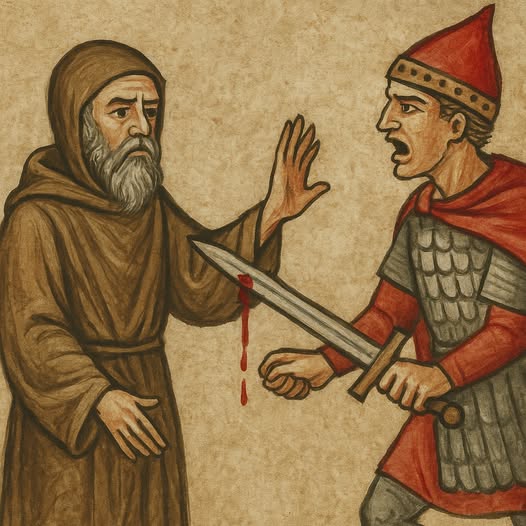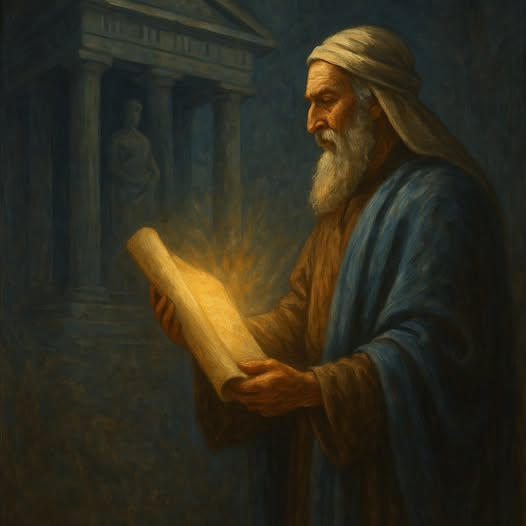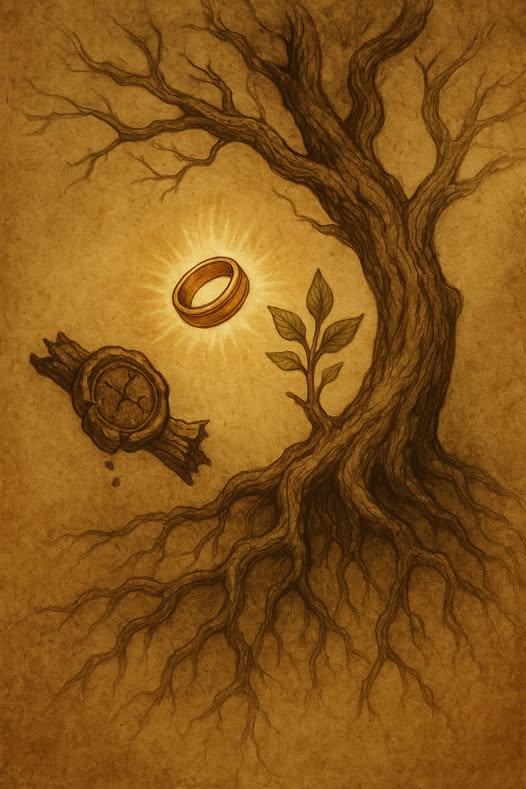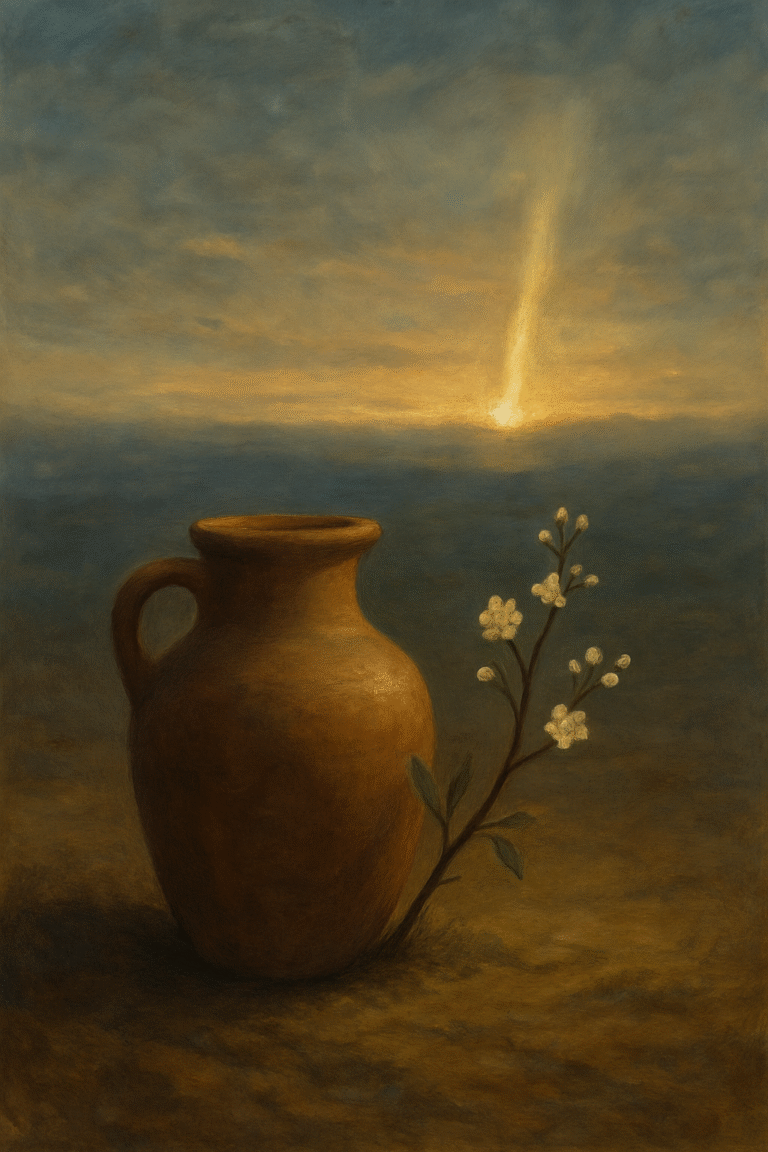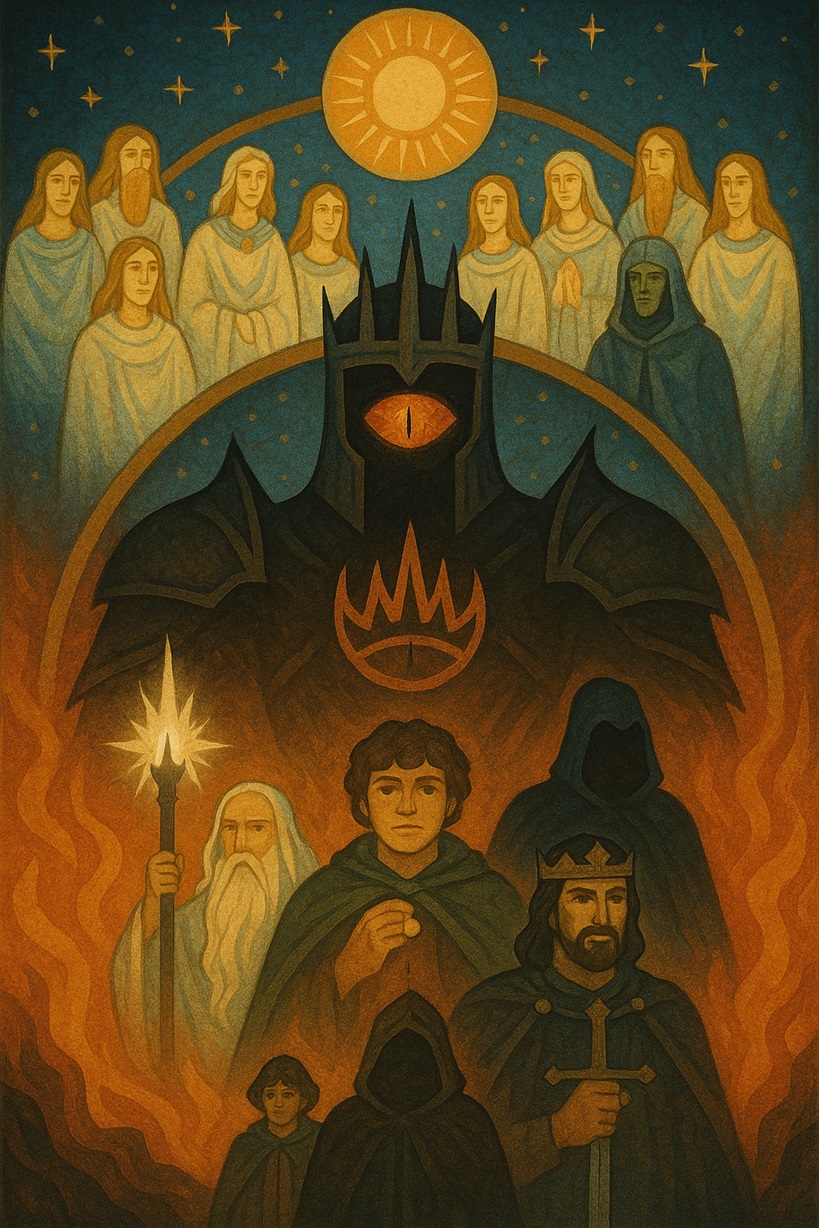
J.R.R. Tolkien believed storytelling was a sacred act. As a devout Catholic, his fiction was shaped not by overt allegory but by deep theological truths. Through the concept of subcreation, Tolkien affirmed that humans, made in the image of the Creator, have the capacity to craft secondary worlds that echo divine realities. While The Lord of the Rings is not an allegory, its themes align powerfully with Christian theology and the Divine Council Worldview (DCWV), a framework in Scripture that speaks of God ruling among other spiritual beings and assigning nations to them after Babel.
The Powers and Principalities of Arda
Tolkien’s legendarium includes a clear divine hierarchy. At the top is Eru Ilúvatar, the One, creator of all. He is the source of the Ainulindalë-the- the Music of the Ainur-through which the world is first imagined. Even when Melkor introduces discord into the harmony, seeking to dominate the music with his own themes, Eru responds not with destruction but with deeper orchestration. He tells Melkor that all the discord he weaves will only serve to make the final symphony more profound. Nothing, not even rebellion, lies outside Eru’s ultimate sovereignty. This reflects a vision of God’s authority that is both supreme and redemptive, where even the schemes of the wicked are ultimately turned to the fulfillment of divine purpose.
Below Ilúvatar are the Ainur, powerful spiritual beings created before the shaping of the world. Among them, the Valar function as guardian spirits of Arda, similar in structure to the Divine Council of Psalm 82. The Maiar, lesser but still mighty beings, assist the Valar. Gandalf and Sauron both belong to this order.
Just as in DCWV, where God delegates spiritual authority to lesser elohim, Tolkien’s mythos reflects a structure where divine beings are given spheres of responsibility. Yet, like in Scripture, rebellion corrupts this order, setting the stage for cosmic conflict. In the end, those spirits who persist in rebellion are not merely restrained but ultimately removed forever from the renewed creation. Their fate reflects the biblical destiny of the fallen sons of God, whose judgment ensures that the restored order will no longer be corrupted by their presence.
Melkor, Sauron, and the Corruption of Divine Authority
Melkor, later known as Morgoth, the mightiest of the Ainur, mirrors the rebel gods in biblical theology. His pride leads him to seek domination rather than stewardship. Morgoth’s rebellion reflects the cosmic insurrection of Psalm 82 and Isaiah 14, spiritual beings grasping for power they were never meant to wield.
Sauron, his chief lieutenant, becomes a second-tier deceiver who continues Morgoth’s dark legacy. Like the sons of God in Genesis 6 and Deuteronomy 32, Sauron imposes false worship and enslaves others, manipulating through fear and domination. The rings of power function almost like tokens of delegated but twisted authority, tools meant for order, turned toward control.
Sacred Geography and Territorial Spirits
Middle-earth is shaped by geography charged with meaning. From the spiritual corruption of Mordor to the divine echoes of Lothlórien and the exile of Númenor, Tolkien paints a world where places are more than political. They are spiritual battlegrounds.
This resonates with the DCWV understanding of cosmic geography, the biblical idea that certain regions are under the influence of rebellious divine beings. Tolkien’s world shows that the land itself can groan under the weight of spiritual oppression or be hallowed by divine presence.
Free Will, Providence, and the Role of Mortals
Tolkien’s theology insists that free will matters, even in a world shaped by fate. This mirrors the DCWV framework in which God’s imagers, both divine and human, are granted real choice. The fall of Melkor and Sauron is not deterministic, nor is Frodo’s endurance guaranteed. Instead, history is a tapestry of choices woven into divine purposes.
Even Gollum, an unlikely figure, plays a providential role through his disobedience. As Elrond says, “Even the very wise cannot see all ends.” God remains sovereign in Tolkien’s world, but human (and hobbit) agency is honored.
At the same time, Tolkien also shows that Ilúvatar does not remain distant. When free will threatens to unravel the entire order of creation-such as with the rebellion of Númenor-Eru steps in directly. That rebellion was not born in a vacuum. It was Sauron, functioning as a kind of Satan figure, who seduced the Númenóreans with promises of godhood, twisting their fear of death into a desire for domination. Under his influence, they turned against the Valar and Ilúvatar himself. In response, Ilúvatar reshapes the world, removes Valinor from its physical reach, and ensures the continuation of his plan. Divine intervention is rare, but never absent, reflecting a theology where human freedom is real, yet ultimately guided by a higher will.
Christ Figures and Divine Reversal
Tolkien avoids a single Christ figure, but the roles of prophet, priest, and king are reflected across characters. Gandalf, as a Maia, is sent back as a resurrected figure who guides and speaks truth. Frodo, the suffering servant, bears the burden of evil though it scars him permanently. Aragorn, the hidden king, returns to heal and rule with justice. Their combined roles reflect a mosaic of messianic themes, aligned with DCWV’s understanding that God’s rule is ultimately restored through His chosen representative.
The Redemption of the Noldor
One of the most profound theological arcs in Tolkien’s legendarium is the redemption of the Noldor. These High Elves, once dwellers in the light of Valinor, chose rebellion. Under Fëanor, they defied the Valar, left the Blessed Realm without permission, and pursued Morgoth in pride and vengeance. Their exile into Middle-earth was a direct consequence of their disobedience, and their long suffering across the First, Second, and Third Ages reflects the cost of that choice.
And yet, by the time of The Lord of the Rings, the story shifts. Elrond, Galadriel, and others of Noldorin descent are no longer defined by rebellion but by wisdom, sacrifice, and faithful stewardship. Galadriel, who once sought dominion and glory, now resists the temptation of the One Ring. Elrond becomes a healer, counselor, and protector. Their final return to Valinor is not a defeat or escape, but a homecoming long delayed. It is the restoration of exiles whose hearts have been refined by ages of sorrow and service.
This echoes the biblical pattern of return from exile, of forgiveness extended to those who wandered far but endured. Their story is not one of perfection, but of transformation. In the end, the Noldor who return do so not in pride, but in humility. And Valinor, far from rejecting them, welcomes them home.
Conclusion
Tolkien didn’t write sermons, but he did what theology often fails to do. He made us feel the weight of glory, the darkness of evil, and the staggering grace of redemption. His myth tells the same cosmic story as Scripture: creation, rebellion, judgment, mercy, and restoration. By embedding DCWV themes into his secondary world, Tolkien baptized the imagination and helped countless readers glimpse the true story beneath all stories.
Discussion Questions
- How does Tolkien’s portrayal of Eru Ilúvatar compare to the biblical view of God’s sovereignty, especially in response to rebellion?
- In what ways does the story of the Noldor reflect biblical themes of exile, refinement, and return?
- How does Tolkien depict the relationship between free will and divine providence across different characters and events?
- What parallels can be drawn between Sauron’s temptation of Númenor and the biblical role of Satan in stirring rebellion?
- How does Tolkien’s treatment of spiritual rebellion and ultimate judgment align with the destiny of fallen divine beings in Scripture?
Want to Know More?
- J.R.R. Tolkien, The Silmarillion
Explores the origins of Arda, the Music of the Ainur, and the exile and redemption of the Noldor. - J.R.R. Tolkien, The Letters of J.R.R. Tolkien
Reveals Tolkien’s own thoughts on myth, theology, and the religious undertones within his legendarium. - Michael S. Heiser, The Unseen Realm
Explains the biblical Divine Council and the cosmic conflict behind human history, paralleling many of Tolkien’s spiritual themes. - Holly Ordway, Tolkien’s Faith: A Spiritual Biography
A modern and accessible account of Tolkien’s Catholic worldview and how it shaped his writing. - Bradley J. Birzer, Sanctifying Myth: Understanding Middle-earth
Provides theological analysis of Tolkien’s world, showing how his myths reflect Christian truths.


